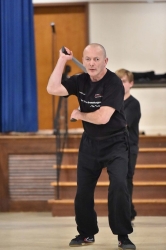
The Karambit in Filipino Martial Arts: A Masterful Dance of Blades
This is by far my favorite weapon in the whole of the Dekiti Tirsia Siradas Arsenal. My folder stays in my pocket as I travel around the US. When we train Karambit in Dekiti Tirsia Siradas we do not put our finger in the hole. SGM Jerson “Nene Tortal has his personal combat applications where he will not use it. However other styles I have trained in using the hole for stability, as well as elongation of the strike. I have even seen styles with will use a flailing action. I would say this all comes down to what you feel is good for you, and truth be told, you may see me with my finger in the hole once in a while.
Introduction: The Graceful Fury of the Karambit
I. The Origins and Evolution of the Karambit
The origins of the Karambit are shrouded in the mists of history. It is believed to have emerged in the Malay Archipelago, including Indonesia, Malaysia, and then eventually the Philippines. The term “Karambit” itself is derived from the Minangkabau language, spoken by the Minangkabau ethnic group of West Sumatra, Indonesia. “Kerambit” in Minangkabau translates to the claw of a tiger or eagle, reminiscent of the curved and razor-sharp shape of the blade.
Originally, the Karambit served as a utilitarian tool for agricultural tasks such as cutting crops, pruning plants, and harvesting. However, its efficient design and sharp curvature made it a formidable choice for self-defense. Over time, it transitioned from a tool of the field to a weapon of the warrior.
II. Anatomy and Features of the Karambit
One of the most distinctive aspects of the Karambit is its unique and elegant design. It boasts a curved blade that resembles the claw of a wild animal. Traditionally sharp on both sides the blade typically ranges from 2 to 7 inches in length and is characterized by a sharp inner curve and a dull back edge. Additionally, the Karambit often features a ring or finger hole at the end of its handle, which serves multiple purposes, including retention, control, and concealment.
The design of the Karambit is a testament to its versatility in both offense and defense. Its compact size and curvature enable it to be easily concealed and maneuvered. This, combined with its sharp edge, makes it a formidable weapon in close-quarter combat situations.
III. Techniques and Applications in Filipino Martial Arts
In the rich tapestry of Filipino martial arts, the Karambit holds a cherished place. It is a symbol of mastery and a testament to the adaptability of FMA practitioners. The techniques associated with the Karambit are diverse and can be divided into offensive and defensive maneuvers:
A. Offensive Techniques
1. Slashing: This would be the most utilized in Dekiti Tirsia Siradas. The curved blade of the Karambit is perfect for slicing attacks, that are used throughout our 12 strike sets. Practitioners utilize circular motions, targeting vital areas of the opponent’s body, such as arteries and joints.
2. Hooking: The curved tip of the blade allows for efficient hooking maneuvers. This technique is used to control an opponent’s weapon or limb.
3. Stabbing: Your initial strike will have a stabbing feel before the slashing. The curved design aids in precise targeting of vulnerable points.
B. Defensive Techniques
1. Trapping: This technique involves trapping an opponent’s limb or weapon using the Karambit’s curved blade, leaving them vulnerable to counterattacks.
V. The Karambit in Modern Times
While the Karambit’s historical roots are firmly embedded in Filipino martial arts, it has also gained popularity on a global scale. The weapon’s unique design and rich history have made it appealing to martial artists, collectors, and enthusiasts worldwide.
A. Martial Arts
The Karambit has found its way into various martial arts disciplines beyond FMA. Its versatility and effectiveness in close combat have made it a sought-after tool for weapon-based self-defense training. Many martial arts schools around the world now incorporate Karambit techniques into their curriculum.
B. Collector’s Item
I have a small collection of karambits, Traditionally made with Carabao horn, and of course a plethora of folders. Other collectors are drawn to the Karambit not only for its functionality but also for its artistic and historical value. The variety of designs, materials, and craftsmanship seen in different Karambits make them a fascinating addition to any collection.
- Writing for Martial Journal; From the Editor - April 29, 2024
- Katheryn Winnick: A Warrior on Screen and in Life - April 14, 2024
- Celebrating Harmony: World Tai Chi and Qi Gong Day, April 27, 2024 - April 10, 2024

Leave a Reply